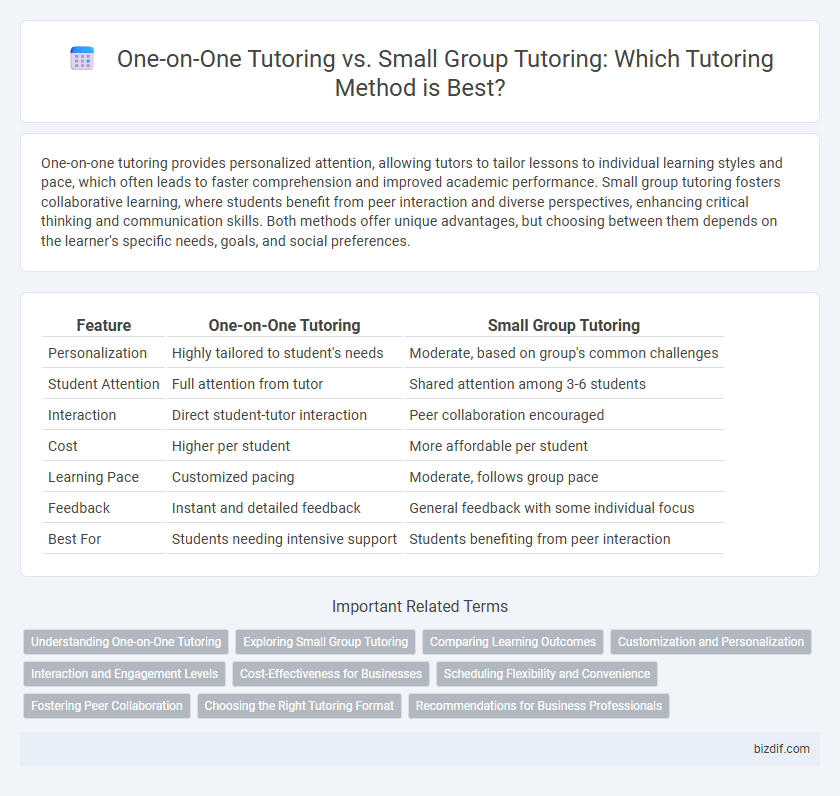One-on-one tutoring provides personalized attention, allowing tutors to tailor lessons to individual learning styles and pace, which often leads to faster comprehension and improved academic performance. Small group tutoring fosters collaborative learning, where students benefit from peer interaction and diverse perspectives, enhancing critical thinking and communication skills. Both methods offer unique advantages, but choosing between them depends on the learner's specific needs, goals, and social preferences.
Table of Comparison
| Feature | One-on-One Tutoring | Small Group Tutoring |
|---|---|---|
| Personalization | Highly tailored to student's needs | Moderate, based on group's common challenges |
| Student Attention | Full attention from tutor | Shared attention among 3-6 students |
| Interaction | Direct student-tutor interaction | Peer collaboration encouraged |
| Cost | Higher per student | More affordable per student |
| Learning Pace | Customized pacing | Moderate, follows group pace |
| Feedback | Instant and detailed feedback | General feedback with some individual focus |
| Best For | Students needing intensive support | Students benefiting from peer interaction |
Understanding One-on-One Tutoring
One-on-one tutoring offers personalized learning tailored to a student's individual strengths and weaknesses, enabling targeted feedback and adaptive pacing. This focused approach enhances comprehension and retention by addressing specific challenges in real time. Research shows students in one-on-one sessions demonstrate higher academic gains compared to small group settings due to increased engagement and customized instruction.
Exploring Small Group Tutoring
Small group tutoring fosters collaborative learning by allowing students to engage with peers in a supportive environment, enhancing both understanding and communication skills. This method often provides a cost-effective alternative to one-on-one sessions while maintaining personalized attention through small group sizes typically ranging from three to five students. Research indicates that small group settings can improve motivation and accountability, leading to higher retention rates and academic success.
Comparing Learning Outcomes
One-on-one tutoring provides personalized instruction tailored to the student's specific needs, leading to faster skill acquisition and higher retention rates compared to small group settings. Small group tutoring fosters collaborative learning and peer interaction, which can enhance problem-solving skills and motivation but may dilute individualized attention. Research shows that while one-on-one tutoring typically results in superior academic performance, small group tutoring offers social benefits that support long-term educational engagement.
Customization and Personalization
One-on-one tutoring offers highly personalized learning experiences tailored to a student's unique strengths, weaknesses, and learning style, enabling precise customization of lesson plans and pacing. Small group tutoring fosters collaborative learning but often requires balancing multiple students' needs, limiting the depth of individual customization compared to one-on-one sessions. Effective tutoring strategies prioritize adaptive instruction, with one-on-one settings excelling in delivering targeted feedback and personalized support that accelerates academic progress.
Interaction and Engagement Levels
One-on-one tutoring offers personalized interaction tailored to the student's specific learning pace and needs, fostering higher engagement and immediate feedback. Small group tutoring promotes collaborative learning and peer interaction, enhancing social skills and diverse perspectives but may limit individual attention. Engagement levels tend to be more intense in one-on-one settings, while small groups encourage active participation through shared problem-solving activities.
Cost-Effectiveness for Businesses
One-on-one tutoring demands higher operational costs per student due to individualized attention and dedicated resources, making it less cost-effective for businesses aiming at scalability. Small group tutoring spreads expenses across multiple students, allowing companies to optimize tutor workload and increase revenue per session. Businesses focusing on cost-efficiency often prefer small group formats, balancing quality instruction with sustainable profit margins.
Scheduling Flexibility and Convenience
One-on-one tutoring offers maximum scheduling flexibility by allowing sessions to be arranged at times tailored specifically to the student's availability, promoting consistent and personalized learning. Small group tutoring requires coordinating multiple students' schedules, which can reduce convenience and limit spontaneous session changes. Personalized time management in one-on-one settings enhances overall accessibility and supports a more adaptable learning experience.
Fostering Peer Collaboration
One-on-one tutoring offers personalized attention, but small group tutoring fosters peer collaboration by enabling students to engage in discussions, share diverse perspectives, and develop communication skills. Collaborative problem-solving in small groups enhances critical thinking and deeper understanding of subject matter. Studies show peer interaction in small groups increases motivation and retention of material compared to individual tutoring sessions.
Choosing the Right Tutoring Format
Choosing the right tutoring format depends on individual learning needs and goals. One-on-one tutoring offers personalized attention and tailored lesson plans, ideal for students requiring focused help or accelerated progress. Small group tutoring promotes collaborative learning and diverse perspectives while remaining cost-effective, suitable for those who benefit from peer interaction.
Recommendations for Business Professionals
Business professionals seeking to maximize learning efficiency should consider one-on-one tutoring for personalized instruction tailored to specific goals and skill gaps. Small group tutoring fosters collaborative problem-solving and networking opportunities but may dilute individual attention. Assessing time constraints and desired outcomes helps determine the optimal tutoring format for professional development.
one-on-one tutoring vs small group tutoring Infographic

 bizdif.com
bizdif.com